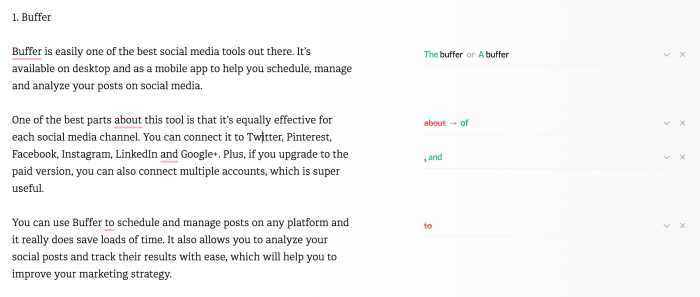
Best free blogging tools are essential for anyone looking to start a blog without breaking the bank. Whether you’re a hobbyist or aspiring professional, having the right tools at your disposal can make all the difference in creating compelling content. Today, we’ll dive into the top free platforms, essential tools for success, and even some monetization strategies to help you turn your passion into profit.
From user-friendly blogging platforms to powerful editing tools, there are numerous options available that cater to various needs. We’ll explore their features, usability, and how they stack up against one another, providing you with a clear picture of what to choose for your blogging journey.
Best Free Blogging Platforms
In the digital age, blogging has become a powerful way to share ideas, stories, and expertise. Choosing the right blogging platform is crucial for anyone looking to establish an online presence. This segment delves into some of the best free blogging platforms available today, examining their features, usability, and the advantages and disadvantages of using them.
Top Free Blogging Platforms
When selecting a blogging platform, it’s important to consider various factors such as user-friendliness, customization options, and available features. Here are some of the leading free blogging platforms worth exploring:
- WordPress.com: Renowned for its flexibility, WordPress.com offers a variety of themes and plugins, making it suitable for both beginners and advanced users. However, advanced features may require a paid upgrade.
- Blogger: Owned by Google, Blogger is easy to set up and integrates well with other Google services. While it’s user-friendly, the customization options can be somewhat limited compared to WordPress.
- Medium: Known for its clean interface and focus on writing, Medium is great for writers who want to reach a broader audience. However, it offers less control over branding and design.
- Wix: With its drag-and-drop functionality, Wix allows users to create visually appealing blogs without any coding knowledge. While it’s user-friendly, the free version includes Wix branding on the blog.
- Weebly: Similar to Wix, Weebly offers a simple drag-and-drop interface and is ideal for small businesses and personal blogs. However, the free version has limitations in terms of features and customization.
Features and Usability Comparison
The usability and features of each platform can greatly influence your blogging experience. Below is a comparison highlighting key aspects of these platforms:
| Platform | Features | Usability |
|---|---|---|
| WordPress.com | Themes, plugins, tools | Moderate learning curve, highly customizable |
| Blogger | Integration with Google services | Very easy to use, limited customization |
| Medium | Clean interface, social features | Simple to use, less design control |
| Wix | Drag-and-drop design, templates | Very user-friendly, some limitations |
| Weebly | Drag-and-drop functionality, e-commerce features | Easy to navigate, but limited in free version |
Pros and Cons of Free Blogging Tools
Utilizing free blogging platforms certainly has its advantages and drawbacks. Understanding these can help you make an informed choice when starting your blog.
Free blogging tools provide a cost-effective way to begin your online journey, but they may come with limitations that could affect your brand’s growth.
- Pros:
- No financial investment needed to start.
- Access to a community of users and potential readers.
- Built-in tools for tracking performance and engagement.
- Cons:
- Limitations on customization and design.
- Potential for ads and branding from the platform.
- Less control over your content and data.
Essential Blogging Tools for Success
To achieve success in the blogging world, having the right tools can make all the difference. These tools help streamline the writing process, enhance productivity, and improve the overall quality of your content. From drafting your posts to promoting them effectively, the right set of tools can empower you to focus on what truly matters: creating engaging and valuable content for your audience.A comprehensive toolkit for blogging includes various categories of tools, such as those for content creation, editing, and email marketing.
Utilizing these tools allows bloggers to refine their craft, manage their audience, and ensure their content reaches its full potential. Below are some essential free tools that can significantly contribute to your blogging success.
Free Tools for Content Creation and Editing
Having a solid foundation in content creation and editing is vital for any blogger. The following tools are instrumental in helping you produce high-quality content while ensuring it is polished and ready for publication.
- Google Docs: An online word processor that allows for easy collaboration and real-time editing. It offers various formatting options and is accessible from any device with internet access.
- Grammarly: This powerful writing assistant checks grammar, punctuation, and style, ensuring that your content is error-free and compelling.
- Hemingway Editor: This tool helps improve readability by highlighting complex sentences and suggesting simpler alternatives, making your writing clearer and more engaging.
- Canva: An easy-to-use graphic design tool that allows bloggers to create stunning visuals for their posts, including infographics, banners, and social media images.
- Unsplash: A free resource for high-quality, royalty-free images that can enhance your blog posts visually without any licensing concerns.
Email Marketing Tools for Integration with Blogging
Email marketing is an essential aspect of maintaining a loyal readership. Effective tools facilitate seamless integration between your blog and your email campaigns, allowing you to reach your audience directly and keep them engaged. Below are some notable free email marketing tools that work well with blogging platforms.
- Mailchimp: A popular choice for bloggers, Mailchimp offers a free tier that allows users to manage up to 2,000 subscribers. It provides customizable email templates and automation options to help you stay connected with your audience.
- MailerLite: Known for its user-friendly interface, MailerLite offers a free plan for up to 1,000 subscribers. It includes features like landing pages and email automation, making it easy to grow your audience.
- SendinBlue: This tool combines email marketing with SMS marketing features. The free plan allows for unlimited contacts, with a daily sending limit, and offers powerful automation features.
- ConvertKit: Tailored for creators and bloggers, ConvertKit’s free plan allows users to build landing pages and automated email sequences, helping to grow your email list effectively.
- Benchmark Email: This tool provides a free plan with up to 3,500 emails per month for up to 500 subscribers. It offers a simple drag-and-drop editor for designing beautiful emails that resonate with your audience.
Monetization Strategies for Bloggers

Blogging can be more than just sharing your thoughts and experiences; it can also serve as a lucrative source of income. Understanding how to monetize your blog effectively is crucial for transforming your passion into profit. This section explores various monetization strategies that bloggers can implement without incurring significant costs, focusing on methods that are accessible and practical for anyone looking to generate revenue from their writing.
Ways to Monetize a Blog for Free
There are several methods bloggers can use to earn money from their blogs without upfront investment. These options leverage existing platforms and tools, allowing bloggers to focus on creating content while generating income simultaneously. Here are some effective strategies:
- Affiliate Marketing: Partner with brands to promote their products through unique affiliate links. When readers purchase through these links, you earn a commission.
- Sponsored Posts: Collaborate with companies that pay you to write posts featuring their products or services. This can be particularly effective if your blog has a solid readership.
- Freelance Writing: Use your blog as a portfolio to attract freelance writing gigs. Many companies look for writers with established blogs.
- Online Courses and Webinars: Share your expertise by creating and selling online courses or hosting webinars to teach your audience valuable skills related to your niche.
Banner Advertising and Its Effectiveness
Banner advertising remains a popular monetization method for bloggers, allowing them to display ads on their sites in exchange for revenue. However, the effectiveness of banner ads can vary significantly based on factors such as site traffic, audience engagement, and the relevance of the ads displayed.
“A study by eMarketer found that banner ad click-through rates average around 0.05%, highlighting the importance of targeted advertising for better results.”
To optimize banner advertising, consider the following:
- Choose the Right Ad Networks: Select networks like Google AdSense or Mediavine that match your audience’s interests for better engagement.
- Ad Placement: Place ads in prominent positions without compromising the user experience. The most effective spots are usually above the fold or within content.
- Monitor Performance: Regularly analyze ad performance metrics to determine which ads generate the most revenue and adjust your strategy accordingly.
Creating and Selling eBooks Through a Blog
eBooks are a fantastic way to monetize your expertise while providing value to your audience. Selling eBooks can create a consistent income stream if done correctly. Here’s a straightforward guide to creating and selling eBooks through your blog:
1. Identify a Profitable Niche
Focus on a topic that resonates with your audience and fills a gap in the market. Research your blog’s analytics to understand what content your readers engage with the most.
2. Write Your eBook
Create informative content that reflects your expertise. Structure your eBook into clear chapters and include actionable insights, ensuring it meets the needs of your audience.
3. Design and Format
Choose an appealing design for your eBook cover and format the interior for readability. Tools like Canva can help with design, while platforms like Scrivener can assist with formatting.
4. Set Up a Sales Platform
Use your blog to create a dedicated sales page for your eBook. Consider platforms like Gumroad or Payhip that allow you to sell digital products directly.
5. Market Your eBook
Leverage your blog, email list, and social media to promote your eBook. Create engaging content surrounding the eBook’s topic to generate interest.By following these steps, bloggers can effectively monetize their knowledge and provide valuable resources to their audience, all while maintaining their blogging integrity.
Conclusion

In summary, the best free blogging tools can significantly enhance your blogging experience, whether you’re just starting or looking to grow your audience. By leveraging these platforms and tools, you can focus on what truly matters—creating great content and connecting with your readers. Remember, the right tools can empower you to not only express your creativity but also open up avenues for monetization that you may not have considered before.
Detailed FAQs
What are the best free blogging platforms?
Some of the top free blogging platforms include WordPress.com, Blogger, and Medium, each offering unique features and usability.
Can I monetize my blog for free?
Yes, you can monetize your blog for free through methods like affiliate marketing, ad placements, and selling eBooks.
Are there free tools for content editing?
Yes, tools like Grammarly and Hemingway are excellent for free content editing and improving your writing quality.
How do email marketing tools integrate with blogging?
Many email marketing tools, such as Mailchimp, offer free plans and easy integration options for your blog to grow and engage your audience.
What are the pros and cons of using free blogging tools?
Pros include cost-effectiveness and accessibility, while cons may involve limited customization options and potential ads on your blog.






